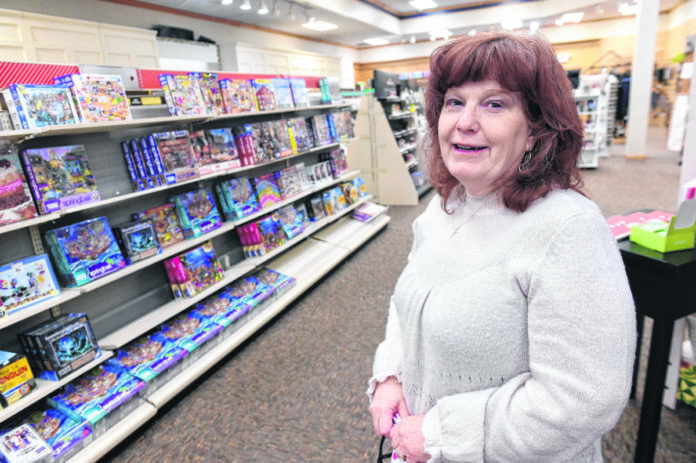
GREENFIELD — Kelley Holden was concerned about the future of her business, Cynthia’s Hallmark in Greenfield, as soon as COVID-19 hit the United States. When the first shutdown orders began in Indiana, she had to close the store’s doors. That also meant furloughing her employees without pay.
Then, Holden applied for and received funding through the federal Paycheck Protection Program. With the money she received from the program, intended to prevent layoffs by offering loans to companies impacted by COVID-19 to pay their employees, Holden was able to re-hire everyone.
“It was really good, because we had no money. We had no income and no cash flow,” Holden said.
Cynthia’s Hallmark is one of hundreds of Hancock County businesses that received funding from the Paycheck Protection Program in 2020. More than 900 businesses received some amount of money, and 114 received $150,000 or more. The payments, intended as a measure to prevent job loss when COVID-19 lockdowns began to devastate the U.S. economy, went out to nearly 5 million companies. The loans can be forgiven if companies use the money mostly to pay their workers.
A second round of the Paycheck Protection Program launched on Jan. 11. Lenders who specialize in working with small businesses owned by minorities got a head start on the new loans, followed by other lenders. A total of $284 billion in funding is available.
The first round of PPP funding generated some controversy when large companies that weren’t struggling financially received some of the money.
For the second round, any company that receives loans of more than $2 million will be audited by the IRS. The program is also targeting smaller companies that have dealt with real financial impact: Borrowers must have fewer than 300 employees and must have experienced a 25% or more reduction in revenue in 2020 compared to 2019.
Some nonprofit groups are also eligible for the funding, including chambers of commerce.
Holden said receiving funding from the program was the reason Cynthia’s Hallmark was able to stay in business. However, she said she did not plan to apply for more funding in this latest round, with business at the store picking back up throughout the past few months.
“As a retailer, we’re doing OK,” she said.
For Jeff Inskeep, the owner of Inskeep Ford in Greenfield, the funds made a major difference in 2020. They allowed him to continue employing all of his workers at their full rate of pay throughout the pandemic, even though some of them were sent home when the business had to close its doors to the public for a while.
“Nobody had a bad year, whether they were working or not,” he said of his staff.
Inskeep said the funds were instrumental in making it through a tough year, even for a well-established business like his that has operated in Greenfield for 60 years.
“It kept us afloat,” he said. “I would be pretty cash-strapped right now without it.”
That said, Inskeep also does not anticipate applying for the latest round of PPP funding. Vehicle sales at his dealership have been good since mid-May, he said. In fact, with some production lines still shut down due to the pandemic, new-car dealers have sometimes run low on cars to sell.
Inskeep, like many local business owners, received his PPP loan through Greenfield Banking Co.
One of the biggest recipients of the funding in Hancock County was Hancock Health. The hospital and health network received approximately $2.9 million. Rick Edwards, the vice president and CFO of Hancock Health, said the infusion of cash was a major help. Most of it was spent on payroll, with some also going toward utility payments.
“It kept us from having to do layoffs this past year,” Edwards said.
Even when some members of Hancock Health staff couldn’t do their original jobs, because state restrictions had temporarily shut down non-essential medical procedures, Hancock Health avoided laying anyone off by assigning them to tasks related to COVID-19. They helped prepare and staff the hospital’s triage clinic for people receiving COVID treatment. Now, some are answering calls to the county’s coronavirus hotline, helping people access treatment or sign up for vaccinations.
Edwards said Hancock Health will consider applying for further loans in this year’s round of PPP funding, adding that anything the government can do to help health-care providers struggling with the financial impact of the pandemic is welcome.
“We’re below our expectations for last year by about $1 million,” he said.
Edwards said one of the best ways to create economic stimulus for the community is for people to stay healthy, something that will help both the hospital and other local businesses return, eventually, to normal.
HOW TO APPLY FOR A PPP LOAN
The application period of Second Draw PPP loans is open until March 31. Loans are administered through a variety of banks. Business owners interested in applying can visit sba.gov to find a map of lenders and more information about applying.
All PPP loans will have the same terms, regardless of lender or borrower. Loans can be used for a variety of expenses, including payroll costs and benefits; utilities; worker protection costs related to COVID-19; and more.
Businesses are eligible for PPP funding if they received funding from the first round of the program; if they have no more than 300 employees; and if they can demonstrate at least a 25% reduction in revenue related to COVID-19.
Some funding is being set aside specifically for borrowers with a maximum of 10 employees, and for businesses that operate in low- to moderate-income areas.
